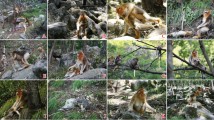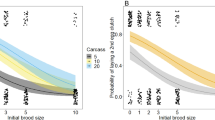Abstract
Although male parental care is rare among mammals1, adult males of many cercopithecine primate species provide care for infants and juveniles. This care is often in the form of grooming, carrying, support in agonistic interactions, and protection against infanticide2,3. For these behaviours to be interpreted as true parental care, males must selectively direct care towards their own offspring and this care must result in fitness benefits4. With the exception of males defending probable offspring from infanticide5, male primates living in multi-male, multi-female social groups have not been shown to selectively direct care towards their own offspring6,7. We determined paternity for 75 juveniles in a population of wild savannah baboons (Papio cynocephalus) and collected data on interventions in agonistic disputes by adult males on behalf of juveniles as a form of male care. Here we show that adult males differentiate their offspring from unrelated juveniles and selectively support their offspring in agonistic disputes. As support in agonistic disputes is likely to contribute to rank acquisition and protect juveniles from injury and stress2,3,5, this can be considered true parental care.
This is a preview of subscription content, access via your institution
Access options
Subscribe to this journal
Receive 51 print issues and online access
$199.00 per year
only $3.90 per issue
Buy this article
- Purchase on Springer Link
- Instant access to full article PDF
Prices may be subject to local taxes which are calculated during checkout

Similar content being viewed by others
References
Woodroffe, R. & Vincent, A. Mother's little helpers: patterns of male care in mammals. Trends Ecol. Evol. 9, 294–297 (1994)
Smuts, B. B. & Gubernick, D. J. in Father–Child Relations (ed. Hewlett, B. S.) 1–30 (Aldine De Gruyter, New York, 1992)
van Schaik, C. P. & Paul, A. Male care in primates: does it ever reflect paternity? Evol. Anthropol. 5, 152–156 (1996)
Trivers, R. L. in Sexual Selection and the Descent of Man 1871–1971 (ed. Campbell, B.) (Aldine, Chicago, 1972)
Borries, C., Launhardt, K., Epplen, C., Epplen, J. T. & Winkler, P. Males as infant protectors in Hanuman langurs (Presbytis entellus) living in multimale groups—defence pattern, paternity and sexual behaviour. Behav. Ecol. Sociobiol. 46, 350–356 (1999)
Paul, A., Kuester, J. & Arnemann, J. The sociobiology of male–infant interactions in Barbary macaques. Macaca sylvanus. Anim. Behav. 51, 155–170 (1996)
Ménard, N. et al. Is male–infant caretaking related to paternity and/or mating activities in wild Barbary macaques (Macaca sylvanus)? C.R. Acad. Sci. III Vie 324, 601–610 (2001)
Altmann, J. et al. Behavior predicts genetic structure in a wild primate group. Proc. Natl Acad. Sci. USA 93, 5797–5801 (1996)
Sherman, P. W., Reeve, H. K. & Pfennig, D. W. in Behavioural Ecology: An Evolutionary Approach (eds Krebs, J. R. & Davies, N. B.) 69–96 (Blackwell Scientific, Oxford, 1997)
Hauber, M. E. & Sherman, P. W. Self-referent phenotype matching: theoretical considerations and empirical evidence. Trends Neurosci. 24, 609–616 (2001)
Singh, D. & Bronstad, P. Female body odour is a potential cue to ovulation. Proc. R. Soc. Lond. B 286, 797–801 (2001)
Wedekind, C., Seebeck, T., Bettens, F. & Paepke, A. J. MHC-dependent mate preferences in humans. Proc. R. Soc. Lond. B 260, 245–249 (1995)
Wedekind, C. & Furi, S. Body odour preferences in men and women: do they aim for specific MHC combinations or simply heterozygosity? Proc. R. Soc. Lond. B 264, 1471–1479 (1996)
Ober, C. et al. HLA and mate choice in humans. Am. J. Hum. Genet. 61, 497–504 (1997)
Jacob, S., McClintock, M. K., Zelano, B. & Ober, C. Paternally inherited HLA alleles are associated with women's choice of male odours. Nature Genet. 30, 175–179 (2002)
Halpin, Z. T. in Kin Recognition (ed. Hepper, P. G.) 220–258 (Cambridge Univ. Press, Cambridge, 1991)
Parr, L. A. & de Waal, F. B. M. Visual kin recognition in chimpanzees. Nature 399, 647–648 (1999)
Widdig, A., Nürnberg, P., Krawczak, M. & Bercovitch, F. B. Paternal relatedness and age proximity regulate social relationships among adult female rhesus macaques. Proc. Natl Acad. Sci. USA 98, 13769–13773 (2001)
Smith, K., Alberts, S. C. & Altmann, J. Wild female baboons bias their social behaviour towards paternal half-sisters. Proc. R. Soc. Lond. B 270, 503–510 (2003)
Alberts, S. C. Paternal kin discrimination in wild baboons. Proc. R. Soc. Lond. B 266, 1501–1506 (1999)
Soltis, J., Thomsen, R., Matsubayashi, K. & Takenaka, O. Infanticide by resident males and female counter-strategies in wild Japanese macaques (Macaca fuscata). Behav. Ecol. Sociobiol. 48, 195–202 (2000)
Silk, J. B. Kin selection in primate groups. Int. J. Primatol. 23, 849–875 (2002)
Palombit, R. A., Seyfarth, R. M. & Cheney, D. L. The adaptive value of ‘friendships’ to female baboons: experimental and observational evidence. Anim. Behav. 54, 599–614 (1997)
Smith, K. L. et al. Cross-species amplification, non-invasive genotyping, and non-mendelian inheritance of human STRPs in savannah baboons. Am. J. Primatol. 51, 219–227 (2000)
Morin, P. A., Chambers, K. E., Boesch, C. & Vigilant, L. Quantitative polymerase chain reaction analysis of DNA from noninvasive samples for accurate microsatellite genotyping of wild chimpanzees (Pan troglodytes verus). Mol. Ecol. 10, 1835–1844 (2001)
Taberlet, P. et al. Reliable genotyping of samples with very low DNA quantities using PCR. Nucleic Acids Res. 24, 3189–3194 (1996)
Alberts, S. C. & Altmann, J. Preparation and activation: determinants of age at reproductive maturity in male baboons. Behav. Ecol. Sociobiol. 36, 397–406 (1995)
Marshall, T. C., Slate, J., Kruuk, L. E. B. & Pemberton, J. M. Statistical confidence for likelihood-based paternity inference in natural populations. Mol. Ecol. 7, 639–655 (1998)
Shaikh, A. A., Celaya, C. L., Gomez, I. & Shaikh, S. A. Temporal relationship of hormonal peaks to ovulation and sex skin deturgescence in the baboon. Primates 23, 444–452 (1982)
Hausfater, G. Dominance and Reproduction in Baboons (Papio cynocephalus) (Basel, Karger, 1975)
Silk, J. B., Alberts, S. C. & Altmann, J. Patterns of coalition formation by adult female baboons in Amboseli, Kenya. Anim. Behav. (in the press)
Acknowledgements
We thank the Office of the President of the Republic of Kenya and the Kenya Wildlife Service for permission to work in Amboseli, and the Institute of Primate Research for local sponsorship. We also thank the Wardens and staff of Amboseli National Park, and the pastoralist communities of Amboseli and Longido for continuous cooperation and assistance. We acknowledge financial support from the National Science Foundation (to J.A., J.B.S. and S.C.A.), the Chicago Zoological Society (to J.A.), the L.S.B. Leakey Foundation and the National Geographic Society (J.B.S). We thank M. Lavine, of the Duke University Statistical Consulting Center, and R. Zimmerman for advice and assistance with statistical tests; R. S. Mututua, S. N. Sayialel and J. K. Warutere for data and sample collection. C. Packer and R. Palombit provided comments on the manuscript.
Author information
Authors and Affiliations
Corresponding author
Ethics declarations
Competing interests
The authors declare that they have no competing financial interests.
Rights and permissions
About this article
Cite this article
Buchan, J., Alberts, S., Silk, J. et al. True paternal care in a multi-male primate society. Nature 425, 179–181 (2003). https://doi.org/10.1038/nature01866
Received:
Accepted:
Issue Date:
DOI: https://doi.org/10.1038/nature01866
This article is cited by
-
Do Wild, Male, Crested Macaques (Macaca nigra) Respond to the Screams of Infants Involved in Agonistic Interactions?
International Journal of Primatology (2023)
-
Conservation and evolution: Inbreeding, small populations, and sex differences in life history
Primates (2023)
-
Male care in a free-ranging group of Japanese macaques (Macaca fuscata)
Primates (2021)
-
High levels of infant handling by adult males in Rwenzori Angolan colobus (Colobus angolensis ruwenzorii) compared to two closely related species, C. guereza and C. vellerosus
Primates (2021)
-
The Phylogenetic Roots of Human Kinship Systems
Biological Theory (2021)
Comments
By submitting a comment you agree to abide by our Terms and Community Guidelines. If you find something abusive or that does not comply with our terms or guidelines please flag it as inappropriate.



